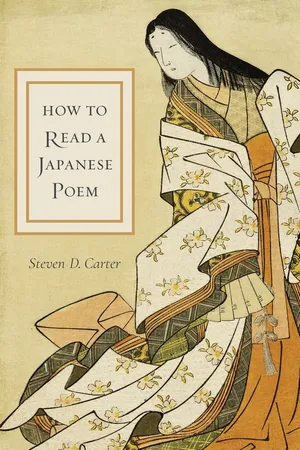
How to Read a Japanese Poem
Steven Carter
- English
- ePUB (mobile friendly)
- Available on iOS & Android
How to Read a Japanese Poem
Steven Carter
About This Book
How to Read a Japanese Poem offers a comprehensive approach to making sense of traditional Japanese poetry of all genres and periods. Steven D. Carter explains to Anglophone students the methods of composition and literary interpretation used by Japanese poets, scholars, and critics from ancient times to the present, and adds commentary that will assist the modern reader.
How to Read a Japanese Poem presents readings of poems by major figures such as Saigy? and Bash? as well as lesser known poets, with nearly two hundred examples that encompass all genres of Japanese poetry. The book gives attention to well-known forms such as haikai or haiku, as well as ancient songs, comic poems, and linked verse. Each chapter provides examples of a genre in chronological order, followed by notes about authorship and other contextual details, including the time of composition, physical setting, and social occasion. The commentaries focus on a central feature of Japanese poetic discourse: that poems are often occasional, written in specific situations, and are best read in light of their milieu. Carter elucidates key concepts useful in examining Japanese poetics as well as the technical vocabulary of Japanese poetic discourse, familiarizing students with critical terms and concepts. An appendix offers succinct definitions of technical terms and essays on aesthetic ideals and devices.
Frequently asked questions
Information


| Ah, the great pit | osaka no |
| at Osaka: | ōmuroya ni |
| so many the men | hito sawa ni |
| who have come here, | kiiriori |
| so many the men | hito sawa ni |
| who here band together! | iriori to mo |
| Yet the Kume men | mitsumitsushi |
| so famed for valor— | kume no ko ga |
| clubs they will take up | kubutsutsu i |
| and swords with pommels of stone, | ishitsutsu i mochi |
| to strike all a fatal blow. | uchite shi yamamu |
| You Kume men | mitsumitsushi |
| so famed for valor: | kume no kora ga |
| clubs you must take up | kubutsutsu i |
| and swords with pommels of stone— | ishitsutsu i mochi |
| for now is the time to strike! | ima utaba yorashi |
Table of contents
- Cover
- Title Page
- Copyright
- Dedication
- Epigraph
- Contents
- Acknowledgments
- Introduction
- Chapter 1. Ancient Song and Poetry
- Chapter 2. Long Poems and Short Poems
- Chapter 3. Popular Songs
- Chapter 4. Linked Verse
- Chapter 5. Unorthodox Poems
- Chapter 6. Comic Poems
- Chapter 7. Poems in Chinese
- Appendix 1: Technical Terms
- Appendix 2: Aesthetic Ideals and Devices
- Notes
- Sources of Japanese Texts
- Selected Bibliography
- Index of Japanese Names, Titles, and Terms
- Illustrations